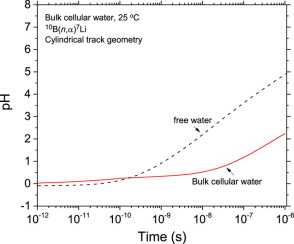Chemical Physics Letters ( IF 2.8 ) Pub Date : 2018-01-05 , DOI: 10.1016/j.cplett.2017.12.037 Muhammad Mainul Islam , Vanaja Kanike , Jintana Meesungnoen , Phantira Lertnaisat , Yosuke Katsumura , Jean-Paul Jay-Gerin

|
Monte Carlo track chemistry simulations of the 10B(n,α)7Li radiolysis of water show that the in situ formation of H3O+ by the two He and Li recoiling ions renders the native track regions temporarily very acidic. For these irradiating ions, the pH remains near 0 at times less than ∼100 ps after which the system gradually returns to neutral pH at ∼0.1 ms. These “acid spikes” have never been invoked in water or in a cellular environment exposed to densely ionizing radiations. The question of their implications in boron neutron capture therapy and, more generally, in hadrontherapy, is discussed briefly.
中文翻译:

在水的10 B(n,α)7 Li辐射分解中原位生成超快速瞬态“酸尖峰”
水中10 B(n,α)7 Li辐射分解的蒙特卡洛轨道化学模拟表明,He和Li的两个反冲离子在原位形成H 3 O +,使自然轨道区域暂时呈酸性。对于这些辐射离子,pH值在小于约100 ps的时间内保持接近0的值,此后系统在约0.1 ms处逐渐恢复到中性pH。这些“酸尖峰”从未在水中或暴露于密集电离辐射的细胞环境中被调用。简要讨论了它们在硼中子俘获治疗中以及更普遍地在强子治疗中的意义。


























 京公网安备 11010802027423号
京公网安备 11010802027423号